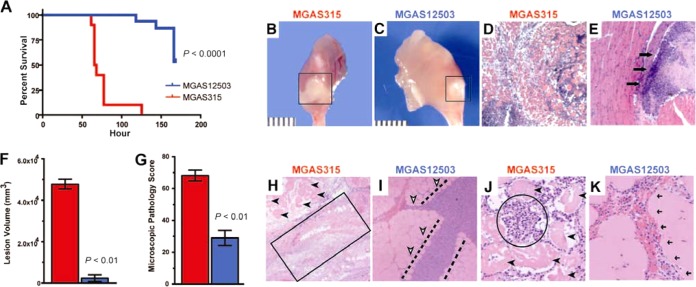FIG 1.
The MGAS12503 carriage strain is significantly less virulent than invasive GAS in necrotizing fasciitis models of GAS infection. (A) Survival curve of mice infected with carriage strain MGAS12503 and invasive strain MGAS315. Ten mice in each group were infected intramuscularly with 1 × 107 CFU, as described in Materials and Methods. P value is relative to MGAS315 as determined by log rank test. Gross pathology (B and C) and histopathology (D and E) (×2 original magnification) of mouse hind limb lesions at 48 h postinfection. Mice infected with strain MGAS315 had extensive spreading myonecrosis and tissue destruction (B, D). In contrast, the lesions in mice challenged with the carrier strain (C, E) had small abscesses confined to the inoculation site. The boxed area and arrows demarcate a circumscribed, walled-off lesion. (F) Cynomolgus macaques were inoculated intramuscularly in the anterior thigh (n = 3 monkeys per strain treatment group), and nonviable lesion volume was measured. (G) Microscopic pathology was scored using objective criteria as described in Materials and Methods. (H) Specimens taken from the inoculation site of monkeys infected with invasive strain MGAS315 show extensive necrosis (boxed region) with complete obliteration of the muscle fascicles and intervening fascial planes (original magnification, ×4). Many nonviable cells (black arrowheads) are seen in the background of necrotic debris. (I) In contrast, monkeys infected with carriage strain MGAS12503 have necrosis that is limited to the fascial planes (area between dashed lines), sparing the adjacent muscle tissue, which retains viability (white arrowheads). (J) At higher magnification (×10 original magnification), the tissue from animals infected with strain MGAS315 is completely nonviable (black arrowheads) and extensively infiltrated by PMN leukocytes (circled region). (K) In comparison, muscle tissue from animals infected with strain MGAS12503 was relatively preserved, with a very limited pattern of infiltration that was restricted to the major facial plane (black arrows).

